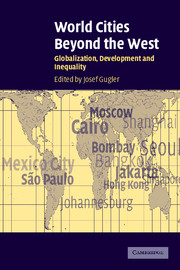Book contents
- Frontmatter
- Contents
- List of figures
- List of maps
- List of tables
- List of contributors
- Acknowledgments
- World cities beyond the West
- Introduction
- Part 1 The impact of the global political economy
- 1 Shanghai: remaking China's future global city
- 2 Seoul: complementing economic success with Games
- 3 Bangkok: evolution and adaptation under stress
- 4 Cairo: too many people, not enough land, too few resources
- 5 Mexico City in an era of globalization and demographic downturn
- Part 2 The impact of the state
- Part 3 The impact of popular movements
- Afterword
- Index
- References
4 - Cairo: too many people, not enough land, too few resources
Published online by Cambridge University Press: 12 October 2009
- Frontmatter
- Contents
- List of figures
- List of maps
- List of tables
- List of contributors
- Acknowledgments
- World cities beyond the West
- Introduction
- Part 1 The impact of the global political economy
- 1 Shanghai: remaking China's future global city
- 2 Seoul: complementing economic success with Games
- 3 Bangkok: evolution and adaptation under stress
- 4 Cairo: too many people, not enough land, too few resources
- 5 Mexico City in an era of globalization and demographic downturn
- Part 2 The impact of the state
- Part 3 The impact of popular movements
- Afterword
- Index
- References
Summary
It is ironic that many of the mega-cities in the non-Western world today, now noted chiefly for their high rates of poverty and their intractable problems of inadequate infrastructure and ineffectual administration, were once counted among the world's outstandingly prosperous and highly cultivated centers of civilization.
As late as the thirteenth century AD, a time I have referred to as “before European hegemony” (Abu-Lughod 1989), half of the dozen largest cities in the world were located in the Far East, three were in North Africa (including Cairo, which was then the third largest city in the world), two were in Andalusia (Muslim-ruled Spain), and one, Constantinople (which ranked just below Cairo in size), lay at the bridge between the Christian and Muslim worlds (Chandler and Fox 1974).
By 1500 little had changed. Of the top twelve cities, eight were located in the Far East and three were in the Muslim Middle East (including Cairo, still at third rank, and the newly conquered Constantinople, renamed Istanbul by the Ottomans, ranking ninth). At that time Paris was the only European city to appear on the list.
By 1700, however, Istanbul, which served as the imperial center for an extensive Ottoman Empire, may have become the most populous city in the world with some 700,000 inhabitants, followed by seven cities in Asia and two others (Isfahan and Cairo) in the Middle East.
- Type
- Chapter
- Information
- World Cities beyond the WestGlobalization, Development and Inequality, pp. 119 - 150Publisher: Cambridge University PressPrint publication year: 2004
References
- 2
- Cited by



